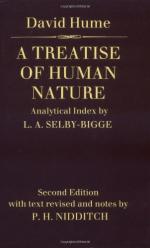
|
| Name: _________________________ | Period: ___________________ |
This test consists of 15 multiple choice questions and 5 short answer questions.
Multiple Choice Questions
1. What does Book One cover regarding human nature?
(a) Passions.
(b) Understanding.
(c) Sympathies.
(d) Knowledge.
2. What does Hume say is stronger than imagination?
(a) Love.
(b) Reality.
(c) Passions.
(d) Memory.
3. Which of the following is unreliable in terms of perceiving things?
(a) Imagination.
(b) Reason.
(c) Senses.
(d) Objects.
4. Hume tells the reader to fix his eye on what kind of spot?
(a) A lead spot.
(b) An ink spot.
(c) A black spot.
(d) A dirt spot.
5. What fruit does Hume use as an example to show our inability to form a just idea without testing it first?
(a) An orange.
(b) A pineapple.
(c) A banana.
(d) A peach.
6. The second truth in Hume's fork principle deals with what?
(a) Judgements.
(b) Matters of principle.
(c) Morals.
(d) Matters of fact.
7. What does Hume say is the only thing senses give us?
(a) Reasons.
(b) Knowledge.
(c) Ideas.
(d) Impressions.
8. What does Hume use his razor theory to devalue?
(a) The imagination.
(b) Mathematics.
(c) Abstract concepts.
(d) Reason.
9. From where does Hume say sensation arises?
(a) The stomach.
(b) The soul.
(c) The eyes.
(d) The spirit.
10. Hume thinks it is pointless to wonder about the existence of what?
(a) The perfect man or woman for ourselves.
(b) The external world and external objects.
(c) The internal world.
(d) The nuclear family.
11. What does Hume say could be the condition of a man who is insensitive to time?
(a) In the middle of a seizure.
(b) In a coma.
(c) Asleep.
(d) Dead.
12. What is the title of Book one, Part Three?
(a) Of Knowledge and Probability.
(b) Of Space and Time.
(c) Injustice Versus Justice.
(d) Morals of the World.
13. How does Hume define productive passions?
(a) As those that produce pleasure and pain.
(b) As those that produce feelings of numbness.
(c) As those that produce mental stimulants.
(d) As those that produce images.
14. Why does Hume say that neither ideas nor impressions are infinitely divisible?
(a) They are a solid fact.
(b) It takes away from the fact that they are complex.
(c) We would eventually arrive at a number too difficult to perceive.
(d) They can only be divided into four.
15. What does Hume identify as the second philosophical relation?
(a) Space and time.
(b) Quality.
(c) Identity.
(d) Resemblance.
Short Answer Questions
1. What does Hume say is a disagreeable impression?
2. Which of the following passions does Hume call an emotion?
3. What kind of soul does Hume believe does not exist?
4. By what does Hume say cousins are connected?
5. What does Hume say is the only thing that can make uncaused choices?
|
This section contains 413 words (approx. 2 pages at 300 words per page) |

|




